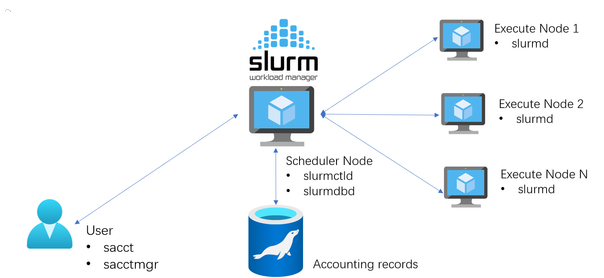Repository of Slurm Job Samples encapsulate GPU resources.

$ sinfo -s
$ scontrol show node <nodename>
$ scontrol show partition <partitionname>
$ sbatch <myjob.sh>
On success expect return <job-id>
Using interactive session with a time limit that will launch a bash shell to run job step by step
$ srun -t 2:00:00 --partition=gpu-queue --nodes=1 --ntasks-per-node=1 --gpus=1 --pty bash -i
$scancel job_id
# verify cancellation
#squeue
Slurm commands communicate with the slurmctld and slurmd daemons to retrieve or modify information about nodes, jobs, and partitions.
$squeue
Beyond using squeue to check the status of a job, here are a few other non-basic ways to get more information about your jobs.
Check the output/error logs in the files you specified in your sbatch script:
#SBATCH --output=my_output.txt
#SBATCH --error=my_errors.txt
For more detailed info about the state of a job:
# sacct provides accounting data for all jobs (running or terminated)
$sacct
$sacct -j <job_id>
$sacct -o ALL -j <jobid>
# detailed information about the status of a specific job including starting/end time, cpus used, task id etc.
$scontrol show job <job_id>
$scontrol show --details job <jobid>
$sstat -j 11600 -o maxrss,maxvmsize,maxdiskwrite
see here for more details: GPU Resource Scheduling
# General
#SBATCH --nodes=2 # Number of compute nodes to use for the job
#SBATCH --ntasks=4 # Number of tasks (processes) to run
#SBATCH --gres=gpu:1 # What general resources to use per node
#SBATCH --mem=32G # How much memory to use
#SBATCH --mem-per-cpu=4G # How much memory to use per cpu
#SBATCH --time=2:00:00 # Time limit for the job
#SBATCH --partition=general # Which partition the job should use
# CPU specific
#SBATCH --cpus-per-task=2 # Number of CPU cores to use for each task
# GPU specific
#SBATCH --gpus=1 # How many gpus to use for an entire job
#SBATCH --gpus-per-node=1 # How many gpus to use per node
#SBATCH --gpus-per-task=1 # How many gpus to use per task
#SBATCH --gpus-per-socket=1 # How many gpus to use per socket
#SBATCH --constraint=gpu_type # What type of gpu to use
#SBATCH --constraint=gmem24G # only use 24G of GPU memory
Note: Generally it is recommended to use --gpus-per-node in most cases combined with --ntasks-per-gpu as all tasks in your job will be guaranteed to have access to a GPU.